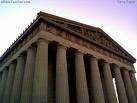
Just a few words on the Bible and form-criticism.
Form criticism as a method is not necessarily an enemy of Christianity as often presumed.
In fact form ciriticism has privileged us to recognise and study the variaty of forms and genres in the Gospels.
However Form criticism as a theory is a different matter.
While Form Criticism applies the methods that may be reasonable for Christians to take on board, the theory also carries a number of presuppositions (which I would call blunders) that Christians need to be aware of.
Firstly, it presupposes that the society of the first century was utter chaos, for example, that people generally, were unable to read, passive and unable to memorize and preserve information, unable to remain united or to organise themselves.
However, this description of the early Christian community is utterly wrong.
The ancient world was highly concerned about preservation even among the illiterate.
Secondly, people in both the Greek and Jewish world were able to read and write. In fact the highest literacy in the first century existed among Jews.
Thirdly, the practicse of memorization, recitation and transmission via a chain of successors was a common practice among both Greeks and Jews.
This simply renders the entire Form-critical postulate on this matter futile and false.
Form criticism also presupposes that a variaty of forms or genres necessarily idenfies a variaty of sources. This idea has continually been utilized by atheists and muslims alike in their attack on the Bible.
For example: Jesus taught individuals (source 1), Jesus taught the crowds (source 2), Jesus spoke in parables (source 3), Jesus spoke wisdom (source 4), Jesus healed the sick (source 5), Jesus travelled back and forward (narrative) (source 6), Jesus died and resurrected (source 7).
Form-critical scholars tend to assume that because these vary in their genre, these must therefore derive from separate sources that the gospel writers must have compiled from various locations, individuals and from different eras of the first century.
Yet is this a reliable conclusion?
Imagine a surgeon who practicing in a university hospital is involved with both teaching and practice.
Let's say that for one day he will be accompanied by an individual who will record every detail, word and deed for this one day only.
1. In the morning he chats with co-workers, students, friends and patients (this is source one).
2. Prior to lunch he gives a tutor session to a student (source two)
3. In the afternoon he lectures to a group of twenty students (source three)
4. Just before take off home, he is called to do an emergency surgery (source four)
5. He drives home (and of course he drow to work in the morning) (source five)
6. Unfortunately on the way he ends up in a serious road accident, which sends him to the hospital, he nevertheless recovers after two weeks (source 6).
If this particular day was to be published in a book and we decided to apply the theory of form criticism in our scrutiny of it, we would certainly agree that we had a number of genres combined, which to general reader simply reveals that the person engaged in a number of situations and activities, each which in their descriptions required their own identical genre, which suggests that this is one on and the same person, yet, from which the form-critic if he applies his methods concludes that this is not the same person.
There you have it: none of us (if we apply form critical methods on the records of our lives) can apply more than one genre to our life, and hence an individual cannot exist.
 A common misconception among the common individual is to view the present New Testament scripture to be the result of centuries of scribal errors, caused by continuous trends of scribal weakness, which consequently changed its text and meaning, rendering the original text as completely lost.
A common misconception among the common individual is to view the present New Testament scripture to be the result of centuries of scribal errors, caused by continuous trends of scribal weakness, which consequently changed its text and meaning, rendering the original text as completely lost.



